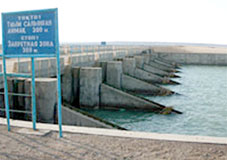Save the Aral Sea
When the Sun began to appear on the Aral Sea (located in Central Asia, north of Kazakhstan, South to Uzbekistan), Alek sailed to the sea. After a moment of letting go of the net, he pulled up from the surface of the net filled with carp, sturgeon and flounder . - something he did not dare to dream about two years ago. ' It's all thanks to this dam, ' said Alek as he poured fish into the train compartment.
As the government of Kazakhstan built from the World Bank (WB) loan, the 13 km long dam dividing the Aral Sea into two parts is part of a $ 68 million project to overcome one of the environmental disasters. worst in the world created by humans, and at the same time revitalizing the Aral Sea that, according to the warning of the UN Environment Program (UNEP) without conservation measures, will disappear completely by 2020.

The dam - ' savior ' of the Aral Sea and local fishermen. (Photo: baoCanTho)
The birth of the dam brought water from the river to ' feed ' the northern Aral Sea. According to Kazakh officials, thanks to the dam, 40% of the water has returned to the sea, opening up hope not only for a more prosperous new life for fishing villages but also reminiscent of the sea memories for the younger generation. local. In early April, Kazakhstan was loaned by the World Bank for an additional $ 126 million to build a second dam to bring the country back to Aralsk port - once the largest port along the Aral coast. The Aral Sea is currently at least 40 km away from the port but according to the Kazakh government, the second phase of the project will make it resurrect in 2010.
Once ranked as the fourth largest lake in the world with an area of about 68,000 square kilometers, the Aral Sea began to narrow down in the late 1960s due to the two large rivers Amu Darya and Syr Darya in Central Asia, the water supply. For the sea, it was transferred to serve irrigation to boost cotton production in Kazakhstan and Uzbekistan. The consequences of widespread use of water for agricultural production have reduced the Aral Sea by 50% and 3/4 of the volume of water.
In the absence of water, the Aral Sea is exhausted, desertification spreads, climate change, destruction of ecosystems, destruction of plants and animals, and forced thousands of locals to evacuate. Each year fishermen have to travel far to get water and fish in the sea less and less. The desertification and salt concentration in the sea increased in the remaining Aral Sea caused salt storms. According to UNEP estimates, every day 200,000 tons of salt and sand from the Aral seabed are swept into the farmland within 300 km of the wind. Saline intrusion destroys fields of livestock and cropland, seriously affecting the health of residents in the region. The consequence of the Aral Sea ' dying ' has pushed local people into misery.
However, the solution of damming water into the sea is not a radical solution. The southern area of the Aral Sea is still narrowing. Environmental experts recommend that the two countries share the Aral Sea as Kazakhstan and Uzbekistan should take urgent action if they want to preserve at least part of the waters.

Image of Aral Sea in 2003 (left) and 2006 (right) (Photo: BBC)
THAI AN
- The Aral Sea is slowly disappearing
- Video time lapse of dryness of the Aral Sea in the past 50 years
- Aral Lake is shrinking rapidly
- The world's fourth-largest sea disappeared completely, inertly dry
- The fourth largest lake in the world is about to disappear
- Kazakhstan indebted to save the dead sea
- Purple aurora in America
- The transformations of the Earth through satellite images
- Kazakhstan: The ghost fleet comes out amidst the desert
- Sustainable agriculture model for alkaline soils
- Super NASA computers simulate a whirlwind from a drone plane
- Symbian encourages cheap 3G services
 Surprised: Fish that live in the dark ocean still see colors
Surprised: Fish that live in the dark ocean still see colors Japan suddenly caught the creature that caused the earthquake in the legend
Japan suddenly caught the creature that caused the earthquake in the legend A series of gray whale carcasses washed ashore on California's coast
A series of gray whale carcasses washed ashore on California's coast Compare the size of shark species in the world
Compare the size of shark species in the world